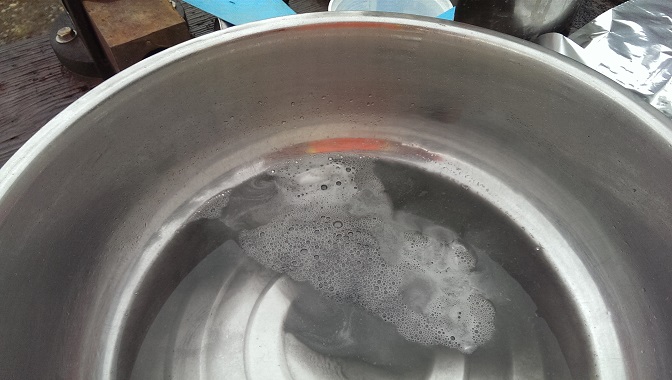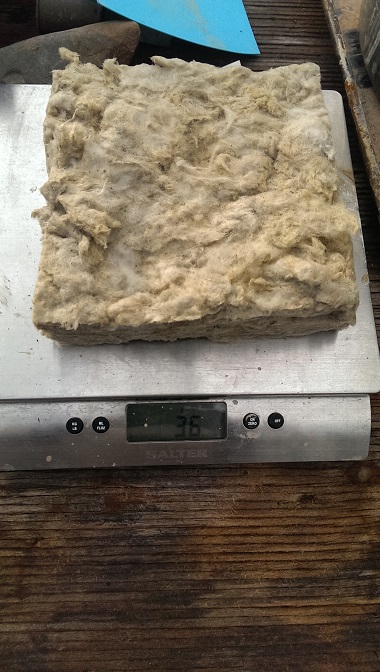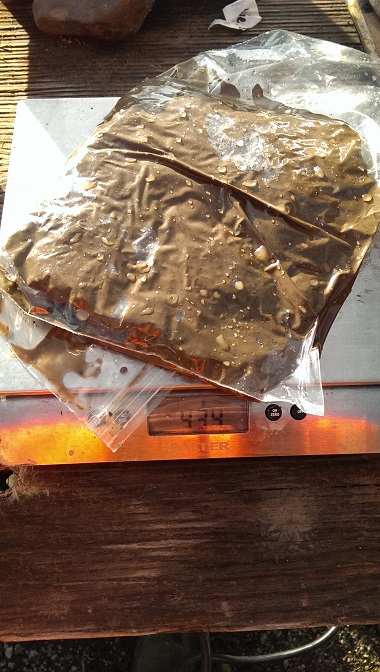|
|
Post by smartliketruck on Sept 30, 2016 15:00:20 GMT -8
I'm mixing a plain clay and water sample to ph check and will look for broad range ph strips when in town next.
I do understand that sodium acetate is also acidic
I don't see the point of forming any more sodium acetate than necessary unless it could be useful for something in the mixture by forming PVA glue for a binder while initial setting takes place or something else useful. When I reacted vinegar and lye, no solids were evident, thus I'm no longer convinced the sudden stiffening of the mixture was a bloom of acetate crystals. In any event it doesn't seem like sodium acetate would be much harm other than increasing amount of lye needed.
I've been playing with applying slurry in a thin layer and brushing with lye solution when air dry. Need to try it indoors as I'm applying on HDPE and PP which have useful thermal expansion properties for de-molding but not so fun when trying to work outdoors.
I've got a few tiles made up with higher lye content and perlite or fine sand as aggregates that I'll do a high temperature cure on soon.
|
|
Deleted
Deleted Member
Posts: 0
|
Post by Deleted on Sept 30, 2016 15:01:40 GMT -8
Why do you insist to publicly demonstrate your komplete lack of general knowledge ?
BTW vinegar has a ph below 3.
Why the obvious fake ?
|
|
|
|
Post by smartliketruck on Sept 30, 2016 17:12:50 GMT -8
Karl: Why do you insist on being cryptic and condescending on someone elses thread?
I started this thread because I didn't want to clutter others work with my misunderstandings, for payment you have cluttered my thread with insults.
I used what ph test I had on hand, it shows the slurry to be on the acidic side.
If a mixture has a low ph would it not use more lye than a neutral mixture?
The comparison to vinegar and the paper scale are there to show that 6 or lower look the same. The well water and lye test shows the ph limits on the other end .
I'm trying to work up my own understanding of what is necessary to form these materials in a shape and method that will suit me. Rammed materials it not my preferred method, I'm looking for poured, hand molded or laminated. I haven't tried adding sodium silicate or gel yet because I've not gotten there yet.
If you truly understand the this polymerization process then please tell me, because I actually want to know.
1. Why make sodium silicate then add it to the mixture rather than have it form with the silicates already in the clay mixture?
2. Why make a binder and then add it to how ever many parts? If I'm making a binder with clay and using clay for an aggregate why not just add the "hot" chemicals to the total parts clay?
3. What would be a better route for adding aluminum, metal dissolved in the hydroxides or in an already oxidized form like aluminum oxide blasting grit.
If you don't like my thread, or have nothing really to contribute other than insults please feel free to not come back.
|
|
Deleted
Deleted Member
Posts: 0
|
Post by Deleted on Oct 1, 2016 4:24:25 GMT -8
If you truly understand the this polymerization process then please tell me, because I actually want to know. The science does not fully understand it yet. So how could I ? But there are very few people smarter than me.  Wet activation of clays is old, much older than science. Bleaching earth is produced in huge amounts, by wet activation. It is well known what happens with the clays during wet activation. Yet nobody, except me, has seen the obvious.  False modesty is not my thing.  The very simple answer: To get something similar to portland cement. Calcium hydroxide and its salts are only slightly soluble in water, thus there is no liquid calcium waterglass. If Calcium hydroxide would be as soluble as the alkali hydroxides Portland cement could be as liquid as waterglass and far more dangerous. Some of the calcium silicates in Portland cement decompose at water contact and release calcium oxide. Basicaly Portland cement can be seen as a mixture of calcium lye and calcium "waterglass", with small amounts of aluminates, iron oxide and gypsum. Otherwise the lye concentration would be far too low too have much effect. In Germany such basic chemistry is teached even on the lowest level of education. Aluminum oxide blasting grit is chemicaly inert. Aluminates can replace waterglass. |
|
Deleted
Deleted Member
Posts: 0
|
Post by Deleted on Oct 1, 2016 5:30:47 GMT -8
|
|
|
|
Post by smartliketruck on Oct 1, 2016 11:44:58 GMT -8
Thanks Karl, I'll mull this over as I go about my chores today.
I'll bump the plant extracts paper up in priority on my reading list, I was already interested due to knowing horsetail plant extracts are used in natureopathic medicine for conditions requiring increased silica levels.
I've also been actively interested in mycology where hot topics are practical mineral extraction for bio-remediation and profit using branches of the fungal kingdom.
The chicken feed I'm about to dole out has selenium in it that wouldn't be bio-available if not processed by yeasts.
|
|
|
|
Post by smartliketruck on Oct 2, 2016 13:48:09 GMT -8
Ah okay, the Making Cements With Plant Extracts paper focuses on the ancients using plant derived acids to obtain minerals for molding from near surface formations and on chemical based tooling of stone. Curious that the Plant Extracts paper says that organic acids are 2-3 times more effective yet the Effect of Activation on Clays and Carbonaceous Materials in Vegetable Oil Bleaching paper seems to favor sulfuric acid for it's higher boiling point yet activation is being done below the boiling point of acetic acid and the melting point of oxalic acid. The sulfuric acid method also requires washing afterwards creating additional waste stream. I need to re-read these to see if I missed something there. I dug a little toaster oven out of storage and it has warm setting that doesn't seem to raise the temperature of the sample much above 80C so long as the samples are shielded from direct radiant heat of the heating elements. The warm setting doesn't appear to utilize the thermostat so unfortunately I can't increase the efficiency with insulation. The oven worked well to dry the samples and do a lower temperature cure except of course the sample using activated clay and binder only. The binder and clay only sample as should be expected lost it's water, shrank and cracked faster than polymerization could happen to hold the piece together. I did a high temperature cure of the pieces and found that there was very little in the way of fissures aside from the major splits that happened during lower temperature curing. This gave me a tactile idea as what to expect with a properly wet cured example would likely be like. I expect it to have somewhat lower density, mechanical strength and durability will far exceed my needs so long as I have the patience to wait for a proper wet low temperature cure. For now I'm playing with fine quartz river sand as one aggregate, but as stated by Karl in other threads on this board it is far from ideal for refactory conditions due to mixed thermal expansion rates of the varied silicates. A local retailer has on the shelf Ebony Grit 20 which is copper slag at $10 CAD for 55lbs it is affordable. I need to look into slag sand as aggregate theory to see if this is a suitable. On a whim at the end of mixing I used a piece of roxul mineral wool batting to mop up the remainders, this shows promise if a more complete saturation is used but experience by others on this forum show it to break down above it's rated 1000C. The composition of the fiber batting can be found at www.lapinusfibres.com/products/engineered+mineral+fibresMore later |
|
|
|
Post by smartliketruck on Oct 2, 2016 18:43:05 GMT -8
The last batch of trials were molded in yogurt containers that were cut down to fit into the toaster oven, they are too flexable which increases cracking on fragile samples.
Due to the samples being cured and dried with heat in one step lye or some other caustic migrated to the surface of the samples with the water and crystallized there just as one would expect with any water soluble salt.
This isn't that evident while handling the samples but if you dampen your hands or touch other skin before washing your hands the tingling start of a burn or at least an irritation is notable, water quickly resolves this if not left for very long.
I do respect strong chemicals, really I do.
When I handle "hot" wet chemicals like lye solution I'm wearing gloves, rain jacket or apron and goggles, and a couple large buckets of water and a garden hose nearby, if a dry powder I'll add on a respirator.
I'm going to mix up a thicker tile tonight and mold it in a container with a lid to see if it will work for a wet, heat accelerated cure.
I've got nearly 25 years of atrophy since highschool and I left early in pursuit of food, shelter and a sense of self determination, I learn or re-learn as need or desire demands.
|
|
Deleted
Deleted Member
Posts: 0
|
Post by Deleted on Oct 3, 2016 3:48:33 GMT -8
Ah okay, the Making Cements With Plant Extracts paper focuses on the ancients using plant derived acids to obtain minerals for molding from near surface formations and on chemical based tooling of stone. That is not the true message of the paper, merely possible applications of it. The true message is what the acids do with the minerals. Did you have made a propper binder this time ? Or are you still wasting time, yours, mine and others ? The fibers are not rated at 1000°C, but above. It is not the heat which destroys the fibers over time, but chemical attack from aggressive flue gas. Though the heat makes it even more aggressive. The fibers are extremely thin and have a large surface per gram. In a geopolymer the fibers will be shielded from the flue gas. |
|
Deleted
Deleted Member
Posts: 0
|
Post by Deleted on Oct 3, 2016 4:16:01 GMT -8
I've got nearly 25 years of atrophy since highschool and I left early in pursuit of food, shelter and a sense of self determination, I learn or re-learn as need or desire demands. Lame excuse. Such basic knowledge saves time and money in everyday life. |
|
|
|
Post by smartliketruck on Oct 3, 2016 13:27:51 GMT -8
The only time I've wasted so far is reading and responding to your slights, if you don't find any value to this thread, it would be illogical for you to keep coming back.
I just cleaned out my inbox but I'm sure the "thread updated" emails have a link to unsubscribe from the thread.
It seems you are trying to find the right blend of somewhat useful information and vitriol to make me and this thread quietly go away or incite an ad hominid attack to have the thread removed.
Would removal of the word geopolymer from the threads title sate your sense of ownership of it within the confines of this forum?
Your abrasiveness aside I am thankful that I came across the information you've posted in this forum, it's opened a portal of discovery for me.
|
|
|
|
Post by smartliketruck on Oct 4, 2016 22:09:34 GMT -8
Back to the fun stuff! So far I've been having the binder activate within a larger proportion of acid activated clay. While it may not be the optimal way I've found it to be an expedient and effective to see what is possible on the low end of binder percentage and what direction I want to take in regard to behavior with aggregate. It also gives me an idea of what a worst case scenario would look like for a poorly mixed pocket. Before the last test batch I watered down the activated clay so that I could strain out the naturally occurring aggregate larger than 4mm. Last night I mixed an approximately 1:1 by dry weight lye beads and wet acid activated clay mixture, when I got around 10-15% of the lye addition there was again a sudden stiffening of the mixture. Since the slurry is still very wet it was easy to mix past the stiffening, the mixture quickly thinned back out and had an almost slippery feel to the spoon. This binder mixture was then left to activate overnight. Today I mixed a few samples. For the first sample I mixed 100g of lye and enough water to easily dissolve the lye at ambient temperature. In this I then fed strips of aluminum foil until the reaction got extremely boring and slow, I used an electric heat gun to accelerate the dissolving of the last few flakes. I added this to the mixing bowl containing 5 parts acid activated clay and 4 parts of the 1:1 binder. In the first minute or two small dispersed clots formed but were blended away as I continued mixing. Again I must warn that the lye solutions are angry, a face or boot full of this stuff will give you a really bad day. Take appropriate precautions!  The second sample was mixed with with a 1:1 ratio of the 1:1 binder and acid activated clay, clotting was not observed. Both samples were poured into polypropylene containers with lids, Approx 1mm water was carefully poured on top and lids clicked on. I managed to fit both samples into the toaster oven on "Warm", temperature was ~85c but will drop as surrounding ambient temperature drops tonight. I used the most of the remaining 1:1 binder to work into a 1/2 thickness piece of roxul board, it was put in a zip sandwich baggie and rolled with a roll of tuck tape. The remaining bowl scrapings which was roughly 1:1 binder and clay was mixed with roughly 3 parts course agricultural perlite by volume. Both are now stored where they should not go below 5C. I'll put them in a clear container as a solar warming oven when the sun is out.   |
|
Deleted
Deleted Member
Posts: 0
|
Post by Deleted on Oct 5, 2016 13:39:03 GMT -8
When something waddles and quacks like a duck it is probably a duck.
What you did is utter nonsense,
needless dangerous and far to expensive.
Likely all will end in the waste bin anyway,
as your other jokes.
|
|
|
|
Post by smartliketruck on Oct 5, 2016 15:09:32 GMT -8
When something waddles and quacks like a duck it is probably a duck. What you did is utter nonsense, needless dangerous and far to expensive. Well anyone who has scanned through your geopolymer threads would likely remember you suggesting adding aluminum to lye for one type of clay or another. I'm curing two samples, one with aluminum and one without, if aluminum has any positive or negative effect with my mixture I want to clearly see the difference. I really don't give a flying foxtrot about what you think of the proportions I'm trying, this is my backyard experiment that I'm doing my way for my own enjoyment. Do you take issue with the way I added the aluminum to the lye solution? I was feeding in strips of aluminum foil to a lye solution in a vessel with large surface area to dissipate the heat, while working outdoors and wearing appropriate PPE. Hardly the conditions for an eruption. Are you suggesting performing the reaction all at once in a closed vessel indoors? If you are referring to the use of the electric heat gun for the last bit of aluminum, as I've said the reaction had minimized in an outdoor environment. Are you suggesting performing the reaction all at once in a closed vessel indoors? Expensive? I used maybe a dollar or two worth of foil and the only reason it cost me anything is because there wasn't any sitting in my recycling bin. You've tried various forms of protest against this thread, I'm starting to hope self immolation is on the short list. |
|
|
|
Post by smartliketruck on Oct 6, 2016 14:33:23 GMT -8
My playing in the mud in my backyard to learn about geopolymers continues.
The two high water content samples that were poured into closed dishes and put in the warming oven have been pulled and left to cure further at room temperature.
The roxul and perlite samples are now in the oven for a warm wet cure, temperature has shown to stay between 60C min and 95C max.
My reasoning behind doing a warm wet cure is to increase the amount of the geopolymer matrix formed so that water removal by gentle heat will be less likely to shrink and crack the wet clay aggregate in the sample.
A slide in the first "(1) Bricks made at low temperature, low energy, low cost " youtube video shows that a LTGS mixture heated to 60C for 5 hours comes close to the strength of a mixture cured at room temperature for 45 days and will exceed it by adding 15 days room temperature curing. This is for a mixture intended for rammed bricks but should still apply for my ketchup consistancy mix.
|
|